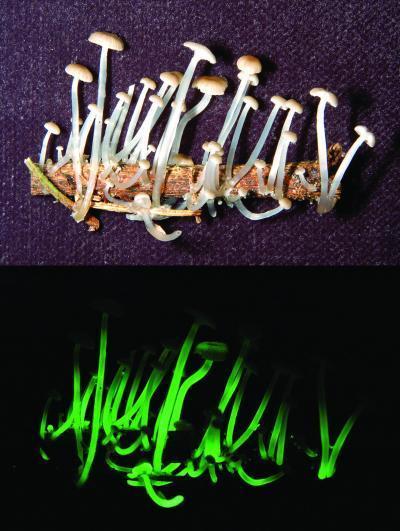7 new species of glowing mushrooms have been discovered
Seven species of 'glowing in the dark' fungi have been discovered, increasing the number of glowing mushrooms known from 64 to 71. Reported in Mycologia magazine, these new findings include two new species. named after parts of Mozart's super bridge. These findings also provide new insights into the evolution of luminescence, in addition to the number of glowing mushrooms.
Professor Dennis Desjardin of San Francisco State University and colleagues discovered mushrooms in Belize, Brazil, Dominican Republic, Jamaica, Japan, Malaysia and Puerto Rico. These findings include 4 completely new species for science and 3 species that have the ability to glow. Three-quarters of the luminous fungi, including those described in this study, belong to the group Mycena genus, a group of edible mushrooms and decompose organic matter as a source of nutrition to sustain life.
 A new luminous mushroom, Mycena luxaeterna was discovered by Professor Dennis Desjardin of Francisco State University and Professor Cassius V. Stevani of the University of Sao Paulo, reported in Mycologia magazine. This species was collected in Sao Paulo, Brazil and found on tree branches in an Atlantic forest area. These mushrooms are very small with mushroom caps smaller than 8 mm in diameter and their stalks have a jelly-like structure. The name of this mushroom is based on Mozart's super musical piece. (Photo: Cassius V. Stevani, Chemistry Institute, University of Sao Paulo).
A new luminous mushroom, Mycena luxaeterna was discovered by Professor Dennis Desjardin of Francisco State University and Professor Cassius V. Stevani of the University of Sao Paulo, reported in Mycologia magazine. This species was collected in Sao Paulo, Brazil and found on tree branches in an Atlantic forest area. These mushrooms are very small with mushroom caps smaller than 8 mm in diameter and their stalks have a jelly-like structure. The name of this mushroom is based on Mozart's super musical piece. (Photo: Cassius V. Stevani, Chemistry Institute, University of Sao Paulo).
Desjardin, the lead author of the study, said: 'What concerns us is that in the Mycena group, luminescent species come from 16 different breeding lines, showing that the luminescence evolved at a single point. and some species later lost this ability. ' He believes that some species of brightly glowing creatures attract animals to help disperse fungal spores, similar to seeds and capable of developing into a new creature.
Desjardin said: 'It is quite strange to find many luminescent species like this, because normally only 2 to 5% of the species we collect in the field are luminescent. I am sure there are still many other species yet to be discovered. " The new fungus has been discovered to have very small yellow-green and yellow light with caps smaller than 1 cm in diameter.
Desjardin has named two species Mycena luxaeterna (eternal light) and Mycena luxperpetua (eternal light), which are inspired by Mozart's super soundtrack and the fact that these mushrooms shine 24 hours a day. To this day, Desjardin has discovered more than 200 new fungal species and, together with the latest findings, he is the author of nearly a quarter of all glowing mushrooms.
The article 'Mycena glows: a new and memorable fungus' was published online in Mycologia magazine on October 5 and will appear in print in March / April 2010. Co-authors include Brian A. Perry, former graduate student at San Francisco State University currently at the University of Hawaii, D. Jean Lodge of the US Forest Service, Cassius V. Stevani of the University of Sao Paulo, Brazil and Eiji Nagasawa of the Mushroom Academy Tottori, Japan. This research is funded by the National Science Foundation and the National Geographic Society.
- Detecting night glowing mushrooms in Brazil
- Learn about exotic mushrooms in Japanese cuisine (1)
- Identify deadly poisonous mushrooms in Vietnam
- Bombshell discovered 3 giant mushrooms never seen
- Two more deep-sea species were discovered
- Discovered extremely poisonous mushrooms in Australia
- Glowing mushroom
- Virtual green light of luminescent mushrooms
- Top 10 most rare mushrooms in Vietnam
- Giant mushrooms appear in mass in Hue
- The 'fairy' world of mushroom species when taking close-ups
- The 10 most unique new species discovered in 2010
 'Fine laughs' - Scary and painful torture in ancient times
'Fine laughs' - Scary and painful torture in ancient times The sequence of numbers 142857 of the Egyptian pyramids is known as the strangest number in the world - Why?
The sequence of numbers 142857 of the Egyptian pyramids is known as the strangest number in the world - Why? History of the iron
History of the iron What is alum?
What is alum?